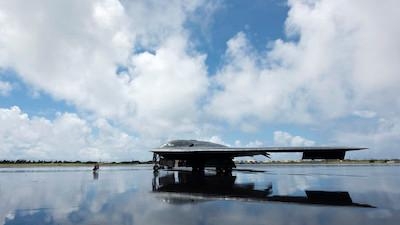Three Spirit Bombers And Some 200 Airmen At Pearl Harbor In August And September
Three B-2 Spirits and approximately 200 Airmen completed their first deployment to Joint Base Pearl Harbor-Hickam, Hawaii, in support of the U.S. Strategic Command’s Bomber Task Force deployment, Aug. 15 through Sept. 27, 2018.

Although bombers regularly rotate throughout the Indo-Pacific, this marked the first deployment of B-2 Spirits to JB Pearl Harbor-Hickam.
"The B-2 Spirits' first deployment to (Joint Base Pearl Harbor-Hickam) highlights its strategic flexibility to project power from anywhere in the world," said Maj. Gen. Stephen Williams, director of air and cyberspace operations, Headquarters Pacific Air Forces. "The B-2s conducted routine air operations and integrated capabilities with key regional partners, which helped ensure a free and open Indo-Pacific. The U.S. routinely and visibly demonstrates commitment to our allies and partners through global employment and integration of our military forces."
Despite the deployment taking place in the middle of hurricane season, the B-2 pilots accomplished hundreds of local and long-duration sorties and regional training. Each mission focused on displaying the bomber’s flexible global-strike capability and the United States' commitment to supporting global security.
One of the key integrations involved the B-2s and F-22 Raptors assigned to the 199th Fighter Squadron, a unit of the 154th Wing under the Hawaii Air National Guard. Like the B-2, the F-22 is virtually invisible to threats. This makes them the perfect match for escorting the stealth bomber and providing situational awareness. The training helped polish the cohesion between the pilots.
“The Bomber Task Force is a total-force integration deployment,” said Lt. Col. Nicholas Adcock, Air Force Global Strike 393rd Bomber Squadron commander. “Our active-duty and guard members worked seamlessly together with their counterparts here in Hawaii to determine the best way for the B-2 to operate from this location in the future.”
The 154th Wing also supported the B-2 with the 203rd Air Refueling Squadron’s KC-135 Stratotankers. Although the B-2 is capable of flying approximately 6,000 miles without refueling, the KC-135s provided aerial refueling for long-duration missions. “The training with the Hawaii Air National Guard was invaluable,” Adcock said. “Together we refined and exercised multiple tactics that are crucial to the Indo-Pacific Command area of responsibility.”
In addition to air operations, the deployment also focused on hot-pit refueling. During this technique, the pilots land and continue to run the B-2’s engines while fuels distribution technicians refuel the aircraft. The pilots are immediately able to take off again with a full tank and maximize the amount of time they are in the air versus on the ground. One B-2 conducted hot-pit refueling at Wake Island, a coral limestone atoll in the mid-Pacific, west of Honolulu, Sept. 14.
Finally, weapons load crews exercised loading BDU-50s, inert 500 pound non-explosive practice bombs, into B-2 bomb bays on the JB Pearl Harbor-Hickam flightline. “This weapons load is the first stepping stone to loading live munitions from this location,” said Master Sgt. Nicholas Lewis, 393rd Aircraft Maintenance Unit weapons section chief. “Furthermore, it provides pilots and load crews valuable training necessary to accomplish future BTF missions.”
From air to ground support, the first Bomber Task Force deployment to Hawaii has allowed each member to determine what it would take to operate the B-2 from JB Pearl Harbor-Hickam and execute strategic deterrence, global strike and combat support at any time. “I am very proud of every Airman that was a member of the 393rd Expeditionary Bomb Squadron,” Adcock said. “We flew to a forward operating location that the B-2 had never operated out of and overcame numerous challenges.”
(Image provided with USAF news release)
 ANN's Daily Aero-Term (04.28.24): Airport Marking Aids
ANN's Daily Aero-Term (04.28.24): Airport Marking Aids Aero-News: Quote of the Day (04.28.24)
Aero-News: Quote of the Day (04.28.24) ANN's Daily Aero-Linx (04.28.24)
ANN's Daily Aero-Linx (04.28.24) Aero-News: Quote of the Day (04.29.24)
Aero-News: Quote of the Day (04.29.24) ANN's Daily Aero-Linx (04.29.24)
ANN's Daily Aero-Linx (04.29.24)



